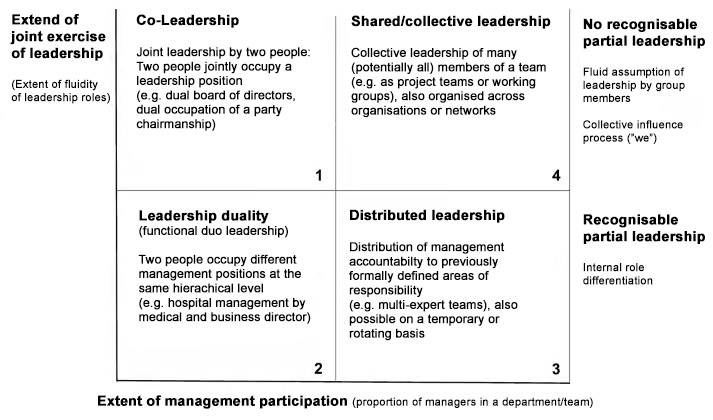The variety of shared leadership
I have often worked with specialists and managers who share (leadership) tasks with other people. The more I look into the concept of shared leadership, the clearer it becomes to me that there are many different terms for it, but no standardised definition or clear usage. In this article, I will try to create a kind of lexicon entry to bring more clarity to the terminology of shared leadership.
Shared leadership: the basis
Shared leadership, also known as distributed leadership, is an umbrella term. It refers to the idea that leadership should not be exercised by one person alone, but can be distributed among several people. The German translation “verteilte Führung” helps to avoid automatically assuming the involvement of just two people, as the term “geteilte” leadership might suggest. Instead, it opens up the space for the idea that leadership can be divided into groups.
In practice, I observe three possible applications of shared leadership in which the concept can come into play. So let’s start our lexicon entry with these scenarios:
1. teams and their leader
If teams and their managers want to work in a more self-organised way or distribute responsibility more decentrally and I conduct workshops (e.g. with the help of the Shared Leadership Compass¹), then this is an application of distributed leadership. Instead of pushing all areas of responsibility onto the manager, we look together at where the various areas of leadership responsibility are best located in the team. In doing so, we take into account the motivation and expertise of all team members. Some of these teams have a connection to agile project management and are familiar with distributed responsibility through frameworks such as Scrum and Kanban.
2. a project team / task force
When a team comes together temporarily to work on a project or solve a problem, it can happen that this team is put together without formal leadership. Without a formal leadership structure, it is equally important in this case to determine the distribution of responsibilities among the team members. Who takes what share of leadership in the team? Here, too, I am talking about a scenario of distributed leadership.
3. job sharing at management level
And here I come to the topic that is often used as a synonym for shared leadership: The sharing of a management position between two people. This is a job-sharing situation with the special feature that the management tasks are performed by two people.
These three examples are scenarios that I experience most frequently in my day-to-day consulting work. I would also like to offer an alternative from the literature: In their book “Plural Leadership”², Sigrid Endres and Jürgen Weibler have also dealt with a distinction between different practical cases of shared leadership and differentiate between four areas:

- Co-Leadership: Exercising all leadership activities in pairs (without recognisable partial leadership)
- Leadership duality: Exercising two different related leadership activities at the same hierarchical level (clearly recognisable partial leadership of both individuals)
- Distributed leadership: Different aspects of leadership are clearly delineated and distributed among several people (clearly recognisable sub-leaderships)
- Shared/collective leadership: All leadership activities are performed equally by a group of people (without recognisable sub-leadership)
Special forms of job sharing with and without management responsibility
There are further conceptual differences in shared leadership in pairs, as the following examples show:
- Job splitting (at management level): Both people have turned one position into two, carry their completely separate areas of responsibility independently and have little to no overlap – an example could be the separation into disciplinary and technical leadership that I often see in everyday life. I would strongly recommend a strong overlap here. In principle, the areas of responsibility are clearly “divided”. (Cf. management duals at Endres and Weibler.)
- Job pairing (at management level): Two people work on the same topics either together or separately in terms of time and share responsibility for all final results; an example could be that two people divide up the weekly working days, but on their respective working days take over the tasks of the other person from the previous day. (See dual leadership at Endres and Weibler.)
- Succession tandem / legacy tandem: This is a combination of a more senior person from the company who is either leaving the job soon or changing roles and a more junior person who is to take over the role after an agreed period of time. One example is new managers who, in a shared position, can settle into their new working environment and the specialised environment with the help of their tandem partner.
- Diversity tandem: The diversity tandem aims to utilise diversity of perspective by having two people who differ in at least one aspect of diversity, such as age, mother tongue or gender, take on leadership together.
- Cross-functional / cross-company tandem: This is where two colleagues from different areas of the company are intentionally brought together to break down silos and promote synergy effects and a solution-orientation.
- Peer tandem: Two people who share an otherwise hard-to-fill position or key position to cover a heavy workload or diverse skill requirements.
This concludes my lexicon entry and I will now leave you to choose the appropriate term for your next discussion about modern leadership and the various forms and characteristics of shared leadership.
Conclusion
Shared leadership is a concept with many facets. In my opinion, it should not be used as a synonym for a leadership task that is shared between two people. Leadership as such is just as diverse as the various forms mentioned here and can therefore often be shared between several people.
When it comes to a leadership task that is carried out by two people, I prefer to use the term tandem leadership because, for me, the dynamic character, the forward movement in pairs, the joint contribution to the result and the fun factor bring some of the advantages of the concept directly to the fore.
Which term do you like best?
Extra bonus
Here you will find 3 additional questions on Shared Leadership answered by Jenny Pfeifer (please click on the plus button):
How can a vacuum of responsibility be avoided with shared leadership?
Jenny Pfeifer: I recommend an initial kick-off meeting (preferably over 2 days) to start the transition to shared leadership. The division of tasks and responsibilities should be an agenda item there, ideally with external support. The Shared Leadership Compass from Chili and Change, for example, can be used to look at all leadership tasks and allocate them to those involved in a joint negotiation process according to motivation and competence. In addition to the pure leadership tasks, there may be other areas of responsibility that are specific to the position and also need to be allocated. These should be collected, clustered and also explicitly assigned in the joint process. The end result can be a table or visualisation in which specific names or roles are specified. For reasons of transparency, this visualisation should also be made available to external stakeholders afterwards and regularly updated.
What is the recommended approach to conflicts between those involved in the shared leadership construct?
Jenny Pfeifer: In principle, conflicts should be seen as an opportunity to resolve tensions and grievances. In shared or distributed leadership, the causes and backgrounds of conflicts can be complex, which is why external moderation is also recommended here. An external person can encourage all parties to speak openly and deal honestly with each other. In management tandems, regular coaching of both parties is useful to prevent conflicts. Feedback sessions are also seen as a helpful means of conflict prevention. At group level, team-building events and feedback are also beneficial in order to continuously get to know each other better, understand the working methods of colleagues and become aware of the values and principles of the people with whom you share leadership responsibility.
What in particular needs to be considered when implementing shared leadership in traditional hierarchical structures?
Jenny Pfeifer: Shared leadership can generally bring added value in all corporate cultures. However, it is always important to consider the expectations of those involved. Shared leadership is not an end in itself and the change from formal one-person leadership to a shared/distributed leadership model should be scrutinised if everything is going well and the teams and the manager are satisfied. In an environment that recognises the fundamental added value (e.g. increased innovation or succession planning) in shared leadership but is still sceptical about the concept, a 1.0 variant can be used to check which parts of leadership can be transferred to other people in the most uncomplicated way before the entire status quo is called into question. A check of the expectations of the previous sole managers and the new co-managers is also essential. With its help, unspoken dissatisfactions and fears can be dealt with. Here, too, an outsider acting as a moderator can provide a certain buffer that serves as the basis for a suitable atmosphere for dialogue.
If you want to improve cooperation in your organisation, Jenny Pfeifer is a very good contact person. Here you will find a felicitous overview in German of what Chili and Change can do for you.
[1] Shared Leadership Compass. My colleague Leonie Heiss has described the use of the tool here in the blog in the article “How does a radically self-organised team work?“.
[2] Sigrid Endres & Jürgen Weibler (2019): Plural Leadership – Eine zukunftsweisende Alternative zur One-Man-Show, https://link.springer.com/book/10.1007/978-3-658-27116-9
[3] Stefanie Junghans & Janina Schönitz (2023). Co-Leadership – Jobsharing als Antwort auf eine veränderte Arbeitswelt. Vahlen.
If you like the post or want to discuss it, please feel free to share it in your network.
Jenny Pfeifer has published another post on the t2informatik Blog:

Jenny Pfeifer
Jenny Pfeifer studied human resources development and communication management in her Master’s degree and then found her way into the world of agile collaboration. She has several years of experience as an Agile Coaches in the IT industry and holds various certificates in Scrum and SAFe. She now works as a change consultant and leadership trainer at the consultancy Chili and Change.
In her daily work, she supports teams, companies and managers on the path to modern collaboration and shared leadership. She draws her motivation from moments of enlightenment for herself and her clients on how to shape the working world of today.
